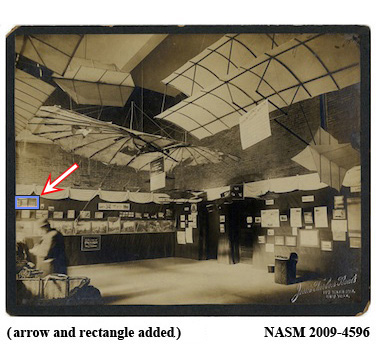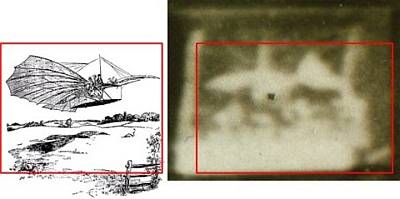Did Gustave Whitehead Beat the Wright Brothers as the First To Fly
 In honor of Wright Brothers' Day, I figured I'd address a topic concerning their reputation as the first people to fly. There's a bit of a movement to try to bestow that honor on a different man - Gustave Whitehead.
In honor of Wright Brothers' Day, I figured I'd address a topic concerning their reputation as the first people to fly. There's a bit of a movement to try to bestow that honor on a different man - Gustave Whitehead.
Whitehead (born Weißkopf, but he changed his name when he moved to America) was an early aviation pioneer who built several unsuccessful flying machines. However, there are claims that he was successful on a few occasions prior to the Wright Brothers. These claims mostly come from a handful of sources - Whitehead's own claims, eye-witness accounts, and a report from the newspaper, the Bridgeport Herald. There's also a newly discovered photo supposedly showing Whitehead in the air. This photo was enough to convince Jane's All the World's Aircraft to officially recognize Whitehead as the first to fly, and for Connecticut to pass a bill proclaiming Whitehead as the first.
The problem is that none of these sources of evidence are particularly reliable. Whitehead himself could hardly be considered an unbiased party, so his claims can only be taken with a grain of salt without independent evidence to back it up.
There are numerous eyewitness accounts of Whitehead making flights. These do help the case, but they're still not ironclad proof. Eyewitness accounts are notoriously unreliable. Just this morning I received my weekly eSkeptic newsletter, with the subject this time being about just how unreliable eyewitness testimony can be (in this case, prompted by the Michael Brown affair in Ferguson). That article has many good examples, but one of my favorites that it didn't include was the Challenger Study (or a similar 911 study). When people were interviewed the day after the Challenger tragedy, they gave an account of where they were and what they were doing when they learned about the explosion. But in a follow-up interview a year later, even though the memories still seemed vivid and real, they had changed, sometimes in very big ways (e.g. hearing about it from classmates vs. watching it live). In the case of Whitehead, most of the affidavits from eyewitnesses are from decades later - more than enough time for memories to become warped.
The local newspaper in Bridgeport published an article about Whitehead and one of his supposed flights. There's some conjecture over how serious the article might have been, but the most damning aspect of it is Whitehead's account of the flight. Speaking as a private pilot and an aerospace engineer, this is not the type of description you'd expect for somebody's first time flying any aircraft, let alone a primitive airplane designed when there was less understanding of controls and stability. Read this passage about his climbout, and how Whitehead did nothing to level his climb, but just rode it out with the machine taking care of it.
When the ship had reached a height of about forty or fifty feet I began to wonder how much higher it would go. But just about that time I observed that she was sailing along easily and not raising any higher.
But this paragraph is the one that really struck me.
And while my brain was whirling with these new sensations of delight I saw ahead a clump of trees that the machine was pointed straight for. I knew that I must in some way steer around those trees or raise above them. I was a hundred yards distant from them and I knew that I could not clear them by raising higher, and also that I had no means of steering around them by using the machinery. Then like a flash a plan to escape the trees came to mind. I had watched the birds when turned out of a straight course to avoid something ahead. They changed their bodies from a horizontal plane to one slightly diagonal to the horizontal. To turn to the left the bird would lower its left wing or side of its body. The machine ought to obey the same principle and when within about fifty yards of the clump of trees I shifted my weight to the left side of the machine. It swung over a little and began to turn from the straight course. And we sailed around the trees as easy as it was to sail straight ahead.
Are we really to believe that Whitehead took off in an airplane without having given any thought beforehand to how he was to control it? It's absurd to imagine that such a flight would be successful, or would have been the leisurely affair that Whitehead described. And as the commentary in the article I linked to describes, the inferred speeds from this flight are impossibly slow. It's just not a plausible scenario.
Now it's time to examine what's actually my favorite part of this 'controversy' - the photographic evidence. There were some press reports that a photo of Whitehead in flight had been on display at the first exhibition of the Aero Club of America in 1906. Noone has been able to find this photo, but a Whitehead advocate, John Brown, thinks he's found evidence of it. The evidence comes from this photo of the exibition:

The box and arrow were added by someone else to show the area of interest to Whitehead supporters. Brown took that region and enlarged it by several thousand percent to get this supposed image of Whitehead in flight:

Brown has a lengthy article describing his analysis of the photo. He also has a description of it on the homepage of Gustave-Whitehead.com, that includes this side by side comparison of the photo to what he thinks it represents.

Now, that's a pretty fanciful interpretation. And Brown appears to be very confident in his analysis despite the obvious lack of detail. But thankfully, we don't have to just wave this off as too vague to be meaningful. Carroll F. Gray has dug into this claim (and many others). Gray has pretty conclusively demonstrated that this photo is not of one of Whitehead's machines, but is rather a glider built by a John J. Montgomery. As much as I would like to steal some of Gray's photos to show in this post, he's put in so much effort that he deserves the visitors at his site. So, in case you missed the link before, here it is again, Update # 5: The Photographs - Whitehead Aloft They Are Not. I highly recommend visiting that page. Even if it's not Whitehead in the air, it's very interesting how Gray was able to track down this scene from such a blurry image and definitively identify the actual scene it's depicting.
Aside from all these poor lines of evidence put forward by the Whitehead advocates, it also helps to take a step back and look at the big picture. The Wright Brothers made their first flight in 1903. They learned their lessons from that flight, went through a few more iterations of flying machines, and by 1908 were giving public demonstations that amazed audiences (though it should be noted that by 1908, there were others flying - just not nearly as well as the Wrights). Whitehead supposedly made his first flight a year or two before the Wright brothers, and then... what? Other than that one questionable article (and many papers that picked up that single story), Whitehead never made headlines with any public flights. He never even built an airplane that could fly after that. How does someone go from being the first in flight to not being able to make another working airplane, despite several attempts?
There's really no good, strong evidence to back up the claim that Gustave Whitehead was the first person to successfully fly an airplane, and there are actually a few indicators that it never happened (like his account of the flight). I think it's possible (though still not backed up with evidece) that he did have some success, maybe even making a vehicle capable of hopping into the air and staying aloft for a few seconds. But the honor of the first in flight still belongs to the Wright Brothers.
---
I came across several interesting articles on these issues (some of which I might have already linked to above).
More Info:
- Scientific American - Connecticut Proclaims Gustave Whitehead Flew before the Wright Brothers
- Scientific American - Scientific American Debunks Claim Gustave Whitehead Was "First in Flight"
- FlyingMachines.org - Gustave Whitehead
- The Aviation Historian - History or Hogwash: A re-examination of claims that Gustave Whitehead flew an aeroplane before the Wright Brothers (pdf)
Image Source: Wikipedia


 Christmas is only two weeks away. Maybe I just haven't been following the right news sources, or maybe the issue's dying out, but I haven't heard a whole lot about the War on Christmas this year. I did Google the phrase, and found that the right wing site,
Christmas is only two weeks away. Maybe I just haven't been following the right news sources, or maybe the issue's dying out, but I haven't heard a whole lot about the War on Christmas this year. I did Google the phrase, and found that the right wing site, 

 With November over, it's time once again to go through the server logs to see what pages on this site were the most popular. The list was largely similar to previous months, with two exceptions. The entry,
With November over, it's time once again to go through the server logs to see what pages on this site were the most popular. The list was largely similar to previous months, with two exceptions. The entry,